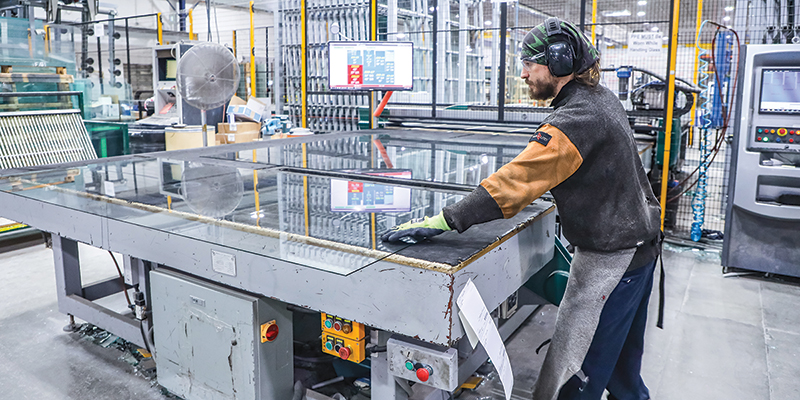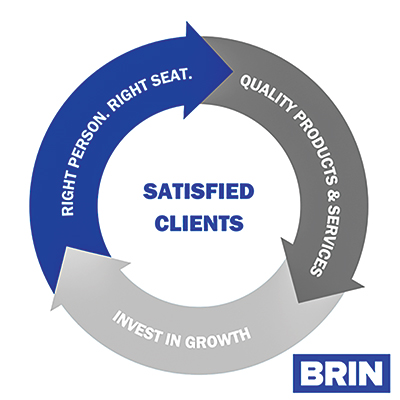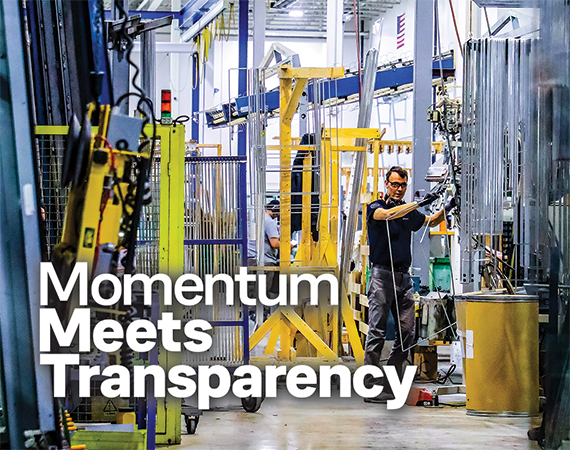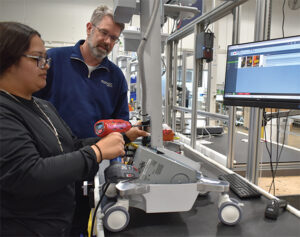Walking through the 100,000-square-foot facility in Fridley, it becomes clear that Northwestern Glass Fab is far more than a successful glass fabrication company — it’s a case study in manufacturing leadership. Through clearly defined processes and cultural alignment, the company is tackling industry challenges like workforce retention, employee engagement, and operational efficiency head-on.
“This is such a unique industry, glass and glazing. It’s quite complex and technical, and (Brin) is an established part of that industry with over 113 years of experience,” says Priscilla Koeckeritz, president and CEO of Brin Glass Company, the parent of Northwestern Glass Fab. She began as a consultant for the company in 2021, became president in 2024, and then took over as CEO this year. “We are proud of the history and legacy of the business, but we also know there’s so much more to do for growth. We have to be future thinking if we want to remain successful.”
How is the fabricator thriving — with steady growth and ongoing additions to the workforce — even in the midst of competition and larger economic uncertainty? Here are the tactics that set them apart and create a solid foundation for even more strategic changes to come.

Drawing on history
As Koeckeritz noted, the company looks for future growth by respecting and honoring the company’s legacy. Northwestern Glass Company was founded in 1908 while Brin Glass Company got its start in 1912, both as Minneapolis-based glass distributors and fabricators.
After the two were competitors for a few decades, Brin acquired Northwestern in 1955 — the company was renamed Brin Northwestern Glass Company in 1978 — and continued to add companies to its portfolio, including Heartland Glass (St. Cloud) and St. Germain’s Glass (Duluth), before establishing an Employee Stock Ownership Plan (ESOP) in 2013. A few years later, fabrication and distribution were relocated to Fridley and the company was rebranded as Northwestern Glass Fab, with the parent company returning to its original Brin Glass Company name.
With four locations, the Brin family of companies has been named as a top 50 contract glazier and a top 50 glass fabricator, by both US Glass Magazine and Glass Magazine for multiple years in a row, Koeckeritz says.
That history isn’t just a timeline that explains the company’s founding and turns along the way, she adds — it’s a point of pride that Northwestern and Brin have celebrated more than 100 years in the glass and glazing business. Historic photos from the 1950s that depict glass fabrication — images that are printed on glass, of course — grace the walls of the Northwestern’s main conference room, and Koeckeritz refers to them as she speaks, as if they were taken just yesterday. That’s a sense of pride that infuses every endeavor, she believes.
“Glass is a very technical industry — the application and needs for each client and project will be different, making it uniquely demanding,” she says. “It requires deep expertise to be done correctly, knowledge to grow into new markets, and bringing in new talent to learn this trade. At Brin, we cover glass and glazing in all facets, from fabrication of products to new construction installation to maintenance of existing buildings, so it requires a lot of knowledge of the product and application in all forms. Most glass companies focus on just one part of this industry, but across Brin, we do it all. We’re fortunate to have this foundation, because it gives us credibility and establishes us as a leader in the industry.”
Turning the flywheel
To put Northwestern Glass Fab’s strategies for growth into context, it’s helpful to look at the overarching principles that drive every aspect of their operation. That starts with a flywheel.
A flywheel is a rotating, mechanical device that harnesses momentum to store energy in a distinctive way, so it can provide power even when an energy source isn’t continuous. Flywheels are used in numerous applications, including gyroscopes, satellites, tractors, and even some toy cars. At Northwestern Glass Fab, their flywheel is more conceptual than actual, but it still provides considerable power.

Called the “Brin Flywheel,” which is part of the company’s values statement, this process puts “satisfied clients” at the center of the wheel, and what keeps the momentum going are three distinct aspects:
Right person, right seat: Hire, train, develop, and retain great employees who communicate well and are engaged with their work.
Quality products and services: Deliver consistent quality and leverage the family of companies to meet customer needs.
Invest in growth: Invest in tools, technology, and automation that allow client relationships to expand and fuel market growth.
“The Brin flywheel is such a strong resource because it articulates what we stand for and what we value,” says Kim Dodge, Brin’s brand development manager. “It’s a framework for helping us deliver results.”
Teamwork and progress monitoring
No matter what the role of an employee — in any industry, of any size — the value of clearly stated objectives, processes, and expectations can be a game changer. When those employees are also part of setting those values? Even better.
Well-established procedures can improve communication, reduce human error, foster accountability, and align with organizational goals overall. That’s the approach that employee-owned Northwestern Glass Fab takes not just on a quarterly basis but every single day.
For example, the company includes expected behaviors in a values guide that every employee receives, and the company core values — We Show Up; We Bring It; and We Do It Right — are displayed visually in common areas. Value’s-based behaviors include:
- Arrive on time, prepared, and ready to contribute
- Meet deadlines; communicate early when challenges arise
- Follow through on commitments to colleagues and clients
- Actively participate in meetings, discussions, and collaborative projects
- Address issues proactively and professionally, without waiting for others to step in
- Approach work with enthusiasm and attention to detail
- Maintain focus on delivering value in every task and project
- Continuously seek improvements, innovations, and opportunities to exceed expectations for clients and teammates
Most likely, any employee handbook will have some version of these values, but the managers at Northwestern Glass Fab are dedicated to having its workforce live these values, not just read them once during onboarding or in an annual HR training session.
That last expected behavior — continuous improvement — is what keeps the flywheel turning with momentum, according to Mike Pennington, Northwestern’s production manager.
“One of the things that tends to stop companies from being able to innovate is lack of information,” he adds. “That’s why we identify metrics that can be followed by everyone on our teams, so we all have the same info in front of us. That is a significant part of getting buy-in for the company vision, because when people feel informed, they feel empowered.”
For example, to ensure that improvements and operations are assessed appropriately, the company tracks weekly progress on specific goals on prominent whiteboards in spots where all 60 Northwestern Glass Fab employees can see them. A red “X” will indicate when a goal is lagging, not alarming on one-off days, but a pattern of consecutive days will require a much closer look, Pennington says.
“We see this as an early warning system,” he says. “It’s a daily communication of expectations that gives people the confidence that what they’re doing is working, and it also provides a way to pivot quickly with corrections if needed.”
The scorecard also shows that Northwestern Glass Fab is transparent in its metrics, he adds. Everyone can see at a glance whether their group is meeting daily goals, he notes.
That approach works beyond the fabrication floor, says Brent Hill, the company’s general manager. Referencing the flywheel, he explains that the “invest in growth” part of the Brin Flywheel attaches metrics and tangible goals for organizational development as well. For that, the company deploys the “vision traction organizer,” a chart that tracks priorities that include financials, talent attraction strategies, how profits are being invested back into the company, and client opportunities.
“This is posted for everyone here to see,” he says. “That makes all of us feel involved in the larger company objectives, and not just in the tasks specific to each job or department.”
Empowerment and talent retention
Encouraging the workforce to voice ideas is another part of seeking continuous improvement, says Koeckeritz. That extends not just to large processes but also any tactic that can be made more efficient — for example, on a tour through the fabrication floor, the glass panels ready for shipping are marked according to their destination, a switch from designating them based on projected pickup day, Pennington says.
“This one simple change has helped streamline our delivery routes,” he notes. “Delivery was working fine before but we knew it could be better and more efficient. So, we figured out how to do that.”
Every production process is similar, he adds: There’s no sentiment of, “this is how we’ve always done it, so this is how it will be done.” The company encourages employee teams to think about how to improve systems and approaches. That’s empowering to team members, Pennington says, and it’s likely one reason the company enjoys low employee turnover. Some employees have been there for decades and frequently refer friends and family members for job openings.
That positive word of mouth image can be very helpful as high schools and technical colleges compete to persuade students to consider careers in manufacturing and construction, Koeckeritz says.
The company is a union shop, so it partners with the union to bring in apprentices while also maintaining a robust presence at career fairs.
Center of the flywheel
The company’s essential emphasis on workforce empowerment, strategic investment, and quality control for all products would mean nothing if customers were unhappy, which is why “satisfied clients” is the center of the entire flywheel. That can be tricky, because the company’s client base is very diverse — from large-scale commercial enterprises to retailers to niche providers that might specialize only in a product like shower doors, for example.
Here’s where over a century of expertise comes in handy, according to Heather Pavlas, the company’s inside sales and support manager. “What sets us apart is that clients can come to us with any kind of question and we will find an answer for them,” she says. “Because we’ve been in the glass industry for so long, and have so much knowledge, we’re able to dig in and offer a personalized, customized solution to what they need. What sets us apart from other fabricators in our industry is that we are part of a family of companies, meaning we have the ability to lean into the expertise of Brin Glass, St. Germain’s Glass, and Heartland Glass, who are glazing contractors installing in the field, which helps us serve our clients in a very unique way.”
Another point of differentiation is the level of feedback and response to that, says Chad Streeter, Northwestern’s sales manager. Northwestern goes above and beyond simply asking for client opinions and experiences, he says. There’s no boilerplate form asking for a rating based on vague definitions like, “quality” or “service.”
Instead, clients provide detailed feedback, which can be quite candid, Streeter says. The company shares feedback throughout the plant, and the sales team lets the client know how that feedback is changing processes.
“People offer feedback more willingly when they know it will make an impact,” Streeter says. “We share how their comments have led to an improvement in some meaningful way. That lets them know that we hear them and we really value what they have to say. It establishes loyalty and trust.”
It’s one reason Northwestern Glass Fab has had some clients for nearly 50 years, Pavlas adds.
“Everything here comes down to the flywheel,” Streeter says. “We share that with clients as well and tell them that if you don’t see us hitting these goals, to call us. Because we will be united as a company to make sure we’re turning that flywheel, every single day.”
Return to the Summer 2025 issue of Enterprise Minnesota® magazine.


